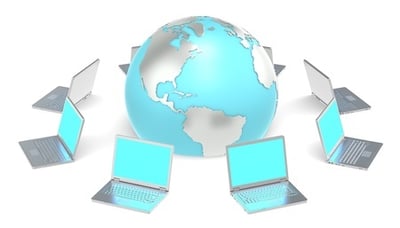Share this
Types of Internet Access | Managed IT and HelpDesk Solutions
by Robert McNicholas on October 24, 2014
 If you’re like me, you tend to connect to the Internet without giving it much thought. And you probably know, via your monthly bill, your Internet service provider (ISP). But have you ever thought about what kind of Internet access you have? I don’t mean in terms of quality or price, or even your personal opinion of the people who run your ISP.
If you’re like me, you tend to connect to the Internet without giving it much thought. And you probably know, via your monthly bill, your Internet service provider (ISP). But have you ever thought about what kind of Internet access you have? I don’t mean in terms of quality or price, or even your personal opinion of the people who run your ISP.
Follow this link to learn 7 facts you didn’t know about the Internet.
For most of us, dial-up Internet, which shared a line with our home phones, is an unlamented thing of the past. And good riddance! Speeds went from slow to slower to impossible if enough of your neighbors happened to log on at the same time. But let’s take a look at some of the other Internet-bringing technologies currently available:
-
DSL, or Digital Subscriber Line, still sends the Internet down our phone lines, but it does it at faster speeds than dial-up. AT&T, for example, offers a respectable 6 Mbps for DSL customers—about 10 times as fast as dial-up. ADSL, which allows for faster download speeds than upload speeds, is a common variant of DSL; higher-speed versions like HDSL and VDSL are less widely available. DSL offers a fairly reliable connection, and it’s often the best choice for areas where cable Internet doesn’t reach. A special filter is used to keep the DSL data from interfering with telephone conversations. It’s actually quite a sophisticated technology.
-
Cable Internet hitches a ride along the coaxial wires of your cable TV provider. Some channel space is used for downloading, other space for uploading. This technology is reliable and quite fast—cable provider Cox offers speeds that range from 5 Mbps to over 100 Mbps.
-
Fiber Optic Internet goes—you guessed it—over special fiber optic cables. It’s not widely available yet, but it’s said to be able to reach speeds over 1Gbps—five to ten times greater than what a fast cable connection can do.
-
Satellite Internet connection is beamed from a satellite to an outdoor receiver that looks very similar to a TV dish. This kind of Internet is used in rural areas, where other connections can be sketchy or nonexistent. However, providers like HughesNet set a data allowance for each customer, and the signal can be very susceptible to rain, snow, and wind.
Most Americans currently connect to the Internet using ADSL, but the push for ever-faster speeds and nearly instant page load times may change all that. Would you change to a faster ISP if you had the option?
Contact Techspert Services today to find out how to make your IT system faster, more efficient, and more secure.
Featured image credit: 123rf.com
Share this
- Featured (119)
- Best Practices (75)
- Business (72)
- Small Business (72)
- Security (43)
- Managed Services (34)
- Business Growth (32)
- Technology News (26)
- Google For Work (22)
- it support (15)
- Social Media (13)
- Technology (11)
- Malware (10)
- Google (9)
- News (9)
- Productivity (9)
- Technology Support (8)
- Cloud (6)
- seo (6)
- Backup Storage (5)
- Website (5)
- Communication (4)
- Ransomware (4)
- Research (4)
- Analytics (3)
- Windows (2)
- anti malware (2)
- email (2)
- how to (2)
- laptops (2)
- mobile (2)
- Hubspot (1)
- data recovery (1)
- twitter (1)
- July 2024 (1)
- June 2024 (2)
- May 2024 (2)
- April 2024 (2)
- March 2024 (2)
- November 2022 (3)
- October 2022 (1)
- September 2022 (3)
- August 2022 (3)
- December 2021 (3)
- November 2021 (3)
- October 2021 (1)
- September 2021 (3)
- August 2021 (3)
- July 2021 (1)
- March 2021 (1)
- February 2021 (7)
- January 2021 (1)
- March 2020 (1)
- August 2019 (1)
- April 2019 (4)
- March 2019 (6)
- December 2018 (10)
- November 2018 (10)
- August 2018 (1)
- July 2018 (9)
- June 2018 (4)
- May 2018 (4)
- October 2017 (3)
- September 2017 (6)
- August 2017 (6)
- July 2017 (12)
- June 2017 (12)
- May 2017 (3)
- March 2017 (5)
- February 2017 (2)
- August 2016 (2)
- June 2016 (4)
- January 2016 (1)
- December 2015 (3)
- November 2015 (3)
- October 2015 (3)
- September 2015 (3)
- August 2015 (2)
- July 2015 (4)
- June 2015 (3)
- May 2015 (2)
- April 2015 (1)
- March 2015 (1)
- February 2015 (1)
- January 2015 (2)
- November 2014 (4)
- October 2014 (11)
- September 2014 (5)
- August 2014 (6)
- July 2014 (6)
- June 2014 (8)
- May 2014 (3)
- April 2014 (3)
- March 2014 (2)

